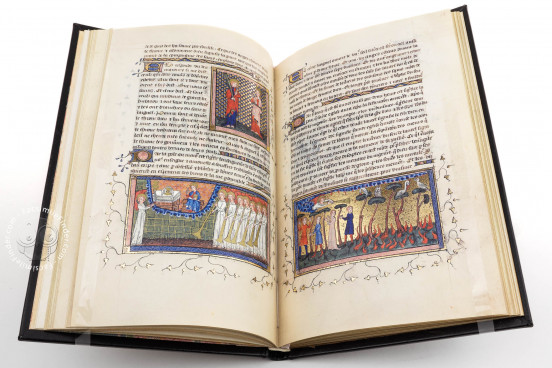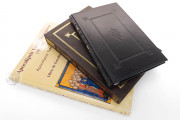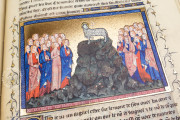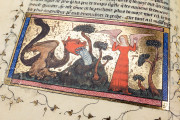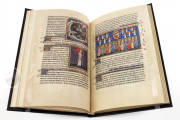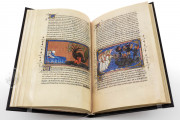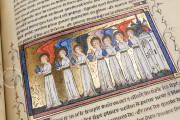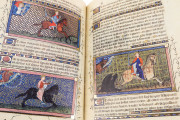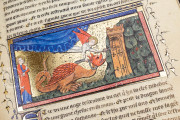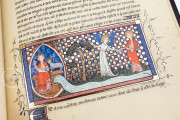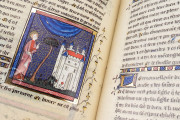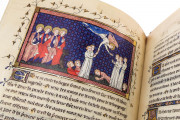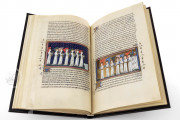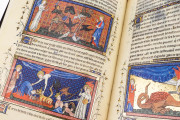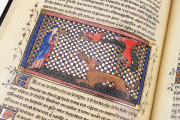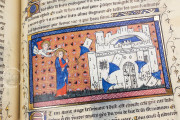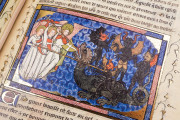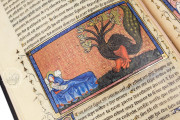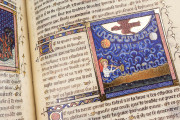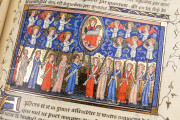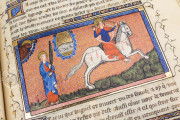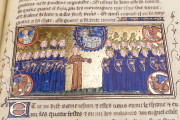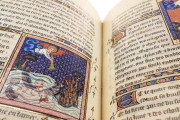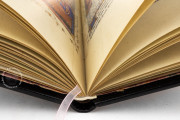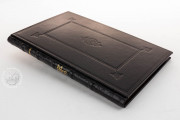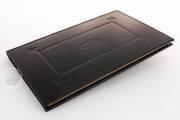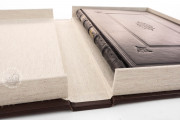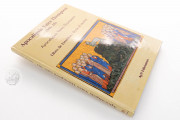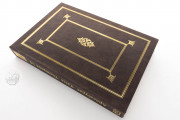The Yates Thompson Apocalypse, named for its last owner, is a mysterious and lavishly decorated manuscript. Produced in the second half of the fourteenth century in Paris (ca. 1370–1390), this French translation of the Book of Revelations offers its readers a stunning visual and textual experience. 70 gorgeous illustrations occupy 40 folios that narrate John the Evangelist’s apocalypse in this de luxe codex: 1 historiated “S” accompanied by a full floriate border opens the text (fol. 1r), and 69 additional miniatures follow.
While little is known about this manuscript’s early history, its later provenance suggests that this French copy of Revelations was prized above all others, and for good reason. Nearly every folio is graced with images of angels and dragons in vibrant hues and gold.
Arresting Gothic Miniatures
The illuminations in the Yates Thompson Apocalypse offer glowing examples of French Gothic art. Likely made by the same master who designed the Coronation Book of Charles V, the illustrations are both animated and impressively detailed.
Some particularly impressive miniatures include the final horseman emerging from the mouth of a grotesque monster (fol. 10r), an angel pulling fellow angels from the Euphrates (fol. 15r), the fall of Babylon (fol. 24r), and the juice of grapes transformed into rivers of blood (fol. 25r).
A Precise and Thoughtful Hand
The entire codex is written in a controlled Gothic Rotunda script. Decorated capitals in blue, pink, and gold begin each new section of text, while new sentences are signaled by in-filled capitals.
There is a clear desire to maintain a solid and consistent text block throughout the manuscript, as what would have been empty lines and spaces are now occupied by attractive line-fillers that match the style of the manuscript's decorated capitals.
Prized Amongst Manuscript Collectors
The first known owner of this manuscript was Jean Philippe Eugène (b. 1674), count of Mérode and marquis of Waterloo, who sold the book in 1734 in Brussels, Belgium.
By the nineteenth century, August Frederick (b. 1801), Duke of Sussex, had possession of the manuscript and added his book-plate on the inside front cover. Frederick, however, sold the manuscript to John Fuller Russell in 1844, and Russell's book-plate now appears over Frederick's.
The codex was then purchased from Russell by the famed collector Bernard Quaritch in 1885. Henry Yates Thompson subsequently purchased the book from Quaritch in 1893 and inscribed his own book-plate with the label "MS 38" on an added sheet at the front of the book (fol. ii recto).
Yates sold the manuscript to Edgar Osborn in 1921, but he soon re-acquired the manuscript from Osborn in 1926. After Yates' death in 1928, his wife Elizabeth Smith handled his collection and bequeathed the manuscript to the British Museum in 1941.
Binding
The binding, which is not original to the manuscript, is a subtle black leather binding with a central floral design that has been stamped onto both the front and back covers. The shelfmark, "Brit. Mus. Yates Thompson 10" is stamped in gold on the cover's spine.
We have 1 facsimile edition of the manuscript "Yates Thompson Apocalypse": Apocalypsis Yates Thompson 10 facsimile edition, published by AyN Ediciones, 2008
Request Info / Price
